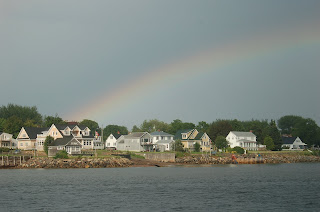Hello, it's Danielle with Quoddy Link Marine, keeping you posted on all things Quoddy.
First, Quoddy Link Marine is going green. Wind turbines have been installed at our office and are currently powering our exterior lighting. Expansions are soon to come and will include interior lighting, cash register, computer and LCD screen. In order to include the interior parts of the office solar panels will have to be added.

Second, I want to report that our upper deck has been certified by Marine Safety to carry 30
passengers instead of 20. Our capacity is still 47 passengers and 3 crew, the change just allows more guests to enjoy the Bay of Fundy breeze at the same time. There are advantages to viewing from both the upper and lower deck. The upper deck gives the advantage of height, allowing our passengers to look down into the water, and on

sunny, clear days you may even be able to see the entire body of a whale through the surface of the water. The lower deck allows you to be at the same level of the water and to view the whales from a completely different angel. The majority of my photos are from the lower deck. The lower deck also allows you to get out of the sun and wind for a while. My advice would be to experience both, the upper and lower deck, it's worth it!
Third, another mom has been reported by Whale Center of New England. Lavalier was photographed with her calf on May 2/07 on Stellwagen Bank.
Another FAQ!!
What kinds of whales will we see?
A very common question. What kinds, or species, of whales we will see will depend on many factors, including; the time of season, the weather and where your captain is willing to take you. The time of season is very important. In our section of the Bay of Fundy, typically minke whales are the first species to arrive (usually around mid-June), the finbacks are next (usually around the beginning of July) and then the humpbacks (usually around mid-August but sometimes as early as the beginning of July).
The weather, another factor we have no control over. Sometimes the weather may dictate where we go, if it's too windy or foggy we may not to be able to travel to the "offshore area", where we usually see the larger whales like finbacks and humpbacks. Minke whales are usually more common in the inshore, protected areas and when the weather is bad, the inshore area may remain calm and relatively warm. Please feel free to check on the weather forecast the evening before your trip but all trips aren't decided upon until about 30 minutes prior to departure.
The one factor we can control is where we choose to take our passengers. If the weather co-operates, and the season is right for larger whales, like finbacks and humpbacks, sometimes

there is a choice where to go. There are many times when there are whales about 10 miles from St. Andrews and whales 16-20 miles from St. Andrews and at these times we may have the choice to stop and stay at the first whales we see......or go further. With Quoddy Link Marine, we always go further. I have worked with the company for 6 years now and I can't think of a time when John or Matt (our 2 captains) didn't choose to go the distance to show our passengers the larger whales. To tell you the truth, we want to see the finbacks and humpbacks as well. Our Scout Boat helps out here as well, scouting the further locations for us, so when we leave St. Andrews we may not even stop at the closer whales (they may be close but there is almost always too much boat traffic). If we can show our passengers finbacks and/or humpbacks over minke whales, we will try. We will also try to leave boat traffic behind, it's not the best viewing experience to have too many boats with the whales and more importantly, it's not good for the whales either.
The most important piece of advice I can give you is ASK QUESTIONS, visit the various tour companies, look at the boats and make an educated decision about the company you want to go whale watching with, and we hope you choose us, Quoddy Link Marine!
That's all for today's update! Keep checking back and we'll see you in St. Andrews!
 This is Shark and she was reported travelling with a calf and Raccoon just east of Stellwagen bank on Saturday, May 26th.
This is Shark and she was reported travelling with a calf and Raccoon just east of Stellwagen bank on Saturday, May 26th.











